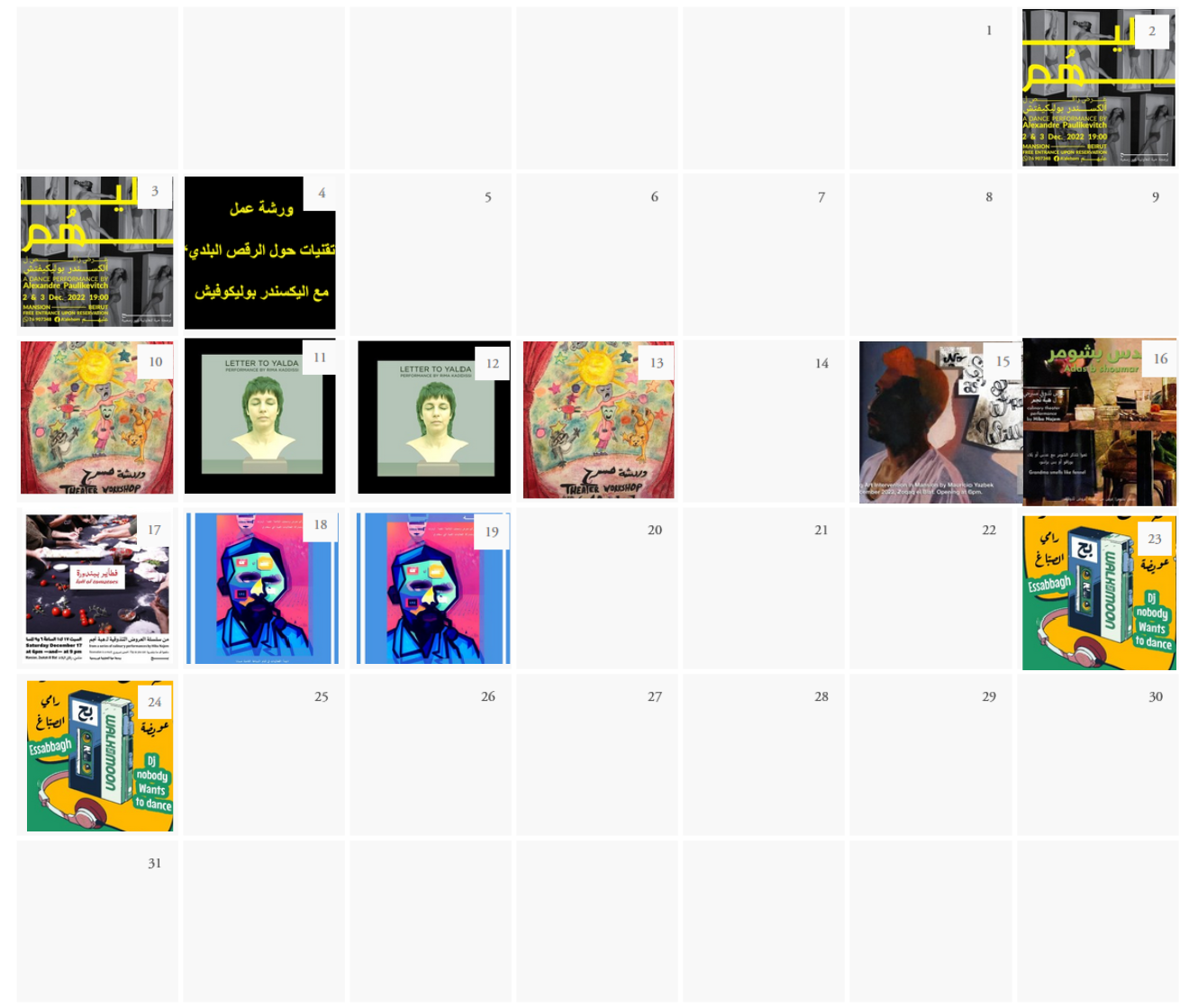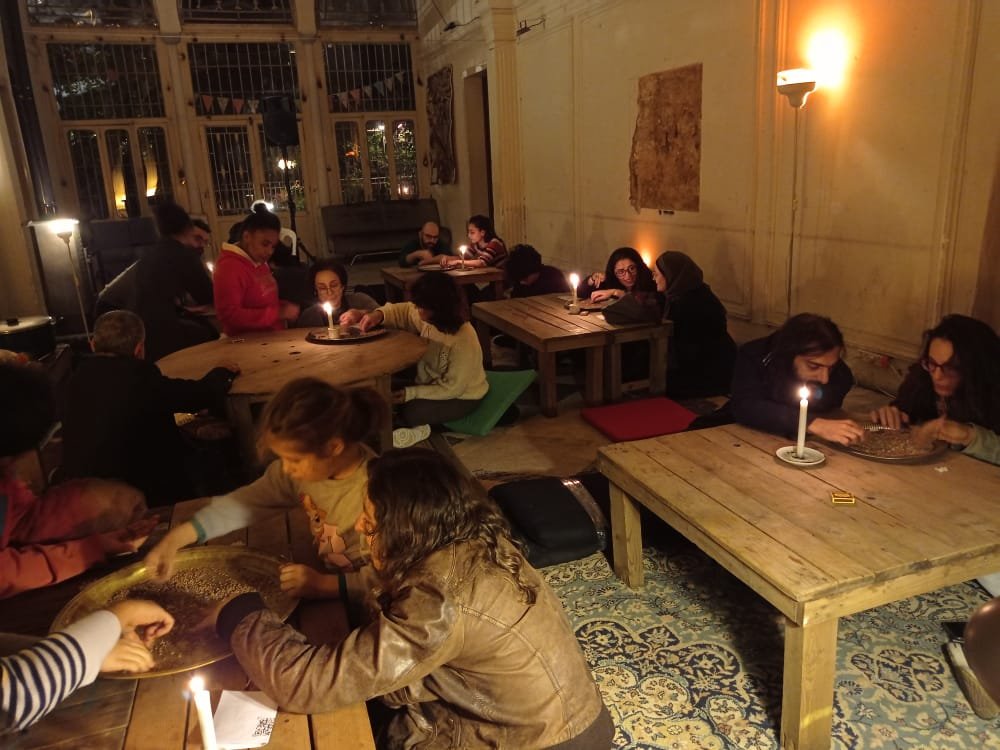
Season 0
And so, the season began.
From the 17th of November, 2022, until the 12th of February 2023, there were six different performances, one movie screening, and one painting exhibition. The opening show was Me, the Idiot, by Sari Mustafa, and it was performed for three days. It was a multimedia experience centered on a world of idiocy that included music, videos, live performances, along with literary writings, and artistic exhibitions. Followed by Aalehom, by Alexandre Paulikevitch, a solo dance performance that was presented two days in a row. It was an intimate work that centered around loss, pain, physical abuse, and revolt, overcoming obstacles, and shedding victimhood. Paulikevitch also ran a workshop on the Sunday following his performances. The month of December was a busy month for Bahh. Mauritzio showcased a painting exhibition in which he reconfigured a room in Mansion that presented a painter’s thoughts and life during their creative process. Hiba Najem then presented two different culinary performances. Lentils with Fennel is a dish from her grandmother’s village, Khyeim, quite popular there it remains unknown by many. In the performance, Hiba tells stories that weave the dish, with the region, a family, and an entire community. The following day Hiba performed another culinary show but this time around, it was about tomato pastries, a forgotten rural dish from her mother’s village, Beit Chabeb. Then, three movies by Wassim Tanius, another Mansion resident, were screened. Though it was quite a busy month, there was still time for a little celebration of the new year and the holidays organized on the 26th of December. The season concluded with Letter to Yalda by Rima Kadissi which witnessed the biggest turnout and was about the urgency to move which combined various visual arts. Though there was another show by Hashem Adnan organized at the end of February, the show was postponed and eventually canceled. This was because of a combination of unforeseen circumstances but also tiredness.
Each performance had different requirements. Some required as small of a team as six people and some required eleven. Yet, many tasks overlapped and were needed for each performance. For example, for each show, Bahh took on the responsibility of managing the entrance to the performance and running the bar. Bahh helped with the setup of the shows, and the space in Mansion. The cooperative wrote invitations and sent them on multiple platforms that were being developed as the shows went on. For instance, they were building a mailing list and asking people to register for it at each performance. A whatsapp group called “Bahh, the Cooperative” was made at the beginning of the season, but after the first show, that included all those who had shown interest in the cooperative and from which broadcasts to the events could be sent. Bahh also launched its website during this time. To gain more publicity, there were stickers given out at the entrance to audience members to be put around the city. Flyers were also written and distributed to introduce the cooperative and Mansion. Each show required various degrees of coordination and in a couple of shows the cooperative paid for certain technical equipment. Bahh also reached out to the media, for example Megaphone and el Mudun, which covered a couple of the shows and the season as a whole.
As of Hiba Najem’s shows and onwards, the cooperative collaborated with a couple of people to open up a small Souk as an opportunity for people to sell their products to audience members. In this souk, there were bougainvilleas sold by a resident of Mansion, Majd; jewelry and art pieces sold by Rawad; seeds sold by Buzu Juzu; and knitted clothes sold by (honestly I don’t remember the name).
We did not keep a record of attendees but we can happily say that at least 230 attended the season because of the mailing list.
The season was an exercise in practice and it was challenging in many ways. It was instrumental to understand how internal organization actually unfolds when it is centered around concrete activities that have to accommodate an artistic team, a technical and coordinating team, and an audience. It was a means to understand how to distribute the workload between members of the cooperative and at times volunteers. It was a way to see whether the cooperative has the capacity to produce shows and bring in wages. It allowed the cooperative to learn how to write invites, create mailing lists and broadcast lists, create a system of reservations, host, and run a bar. It was essential also to understand how ‘Pay as you can’ functions. These are just some of the tasks but a season of performances is a huge endeavour and included so much more.
To be honest, there were burnouts. There were fights. There were even disappointments. There were no huge profits. With 70% of each show going to the artists, and 30% to Bahh, along with all the expenses paid for the shows, at the end of the season we had 366$ in our treasury. The season was initially devised as having a week of performances and two weeks of a break which could include a workshop. But as far as things go, what we imagine isn’t always what happens. Yet, even though it didn’t go exactly as planned, it still went and the audience grew with each passing show, and so did the mailing list, and so did relations within bahh, between bahh and artists, and between bahh and all those who were attending the shows. There was a beauty to it and lots of love.
The core team behind season zero include: Ahlam Dirani, Hashem Adnan, Nassim Banna, Nour Chamaa, Hiba Najem, Rima Kadissi.
Yet, the season could not have happened with the help of the artists and their own artistic teams. The vital help of close friends, Sari, Abed, Ghassan, Nadim, Rawad and Jana and some volunteers, Abir, Hiba, Fatima, Nour, Yasmina, and Racha.













